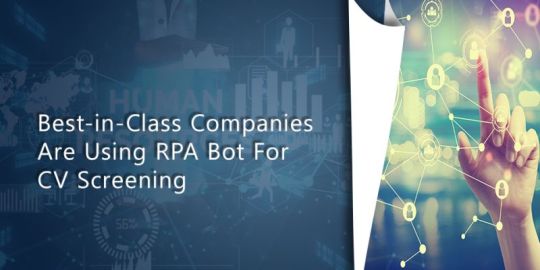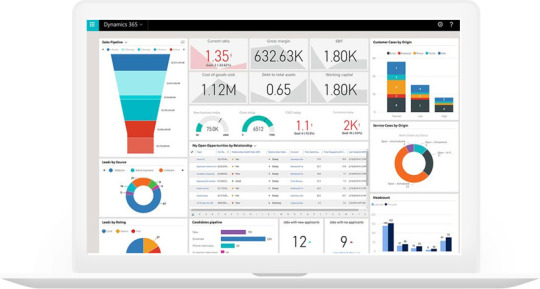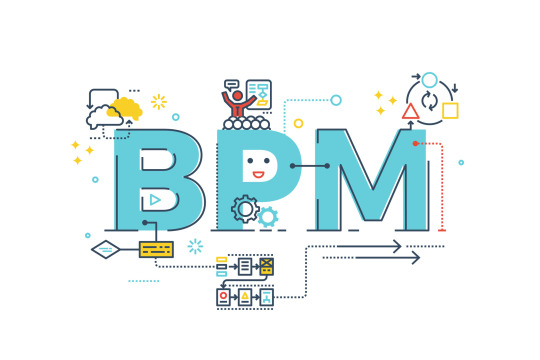#rpa in hr
Text
0 notes
Text
Human Resources Software: Leveraging RPA to Transform HR Operations

Human resources software that leverages RPA can help you transform your HR operations. Discover how RPA can help you automate tasks, improve accuracy, and boost efficiency to achieve in HR.
#hr software#human resources management software#hr in software#RPA in HR#Human Resources Software#RPA in Human Resources#Benefits of RPA in HR#RPA use cases in HR#RPA for HR service providers#Human resources software
0 notes
Text
Reduce Human Errors With RPA Implementation Services

Are you in search of a proven solution that can help you in reducing human errors in business operations? If so, you should opt for RPA implementation services from a reliable tech partner. With RPA implementation, day-to-day administrative tasks can be automated resulting in improved productivity, efficiency, and accuracy.
0 notes
Text
Data Visualization Excellence: Power BI's Impact on UAE Business Intelligence
The capacity to successfully utilize data is a vital component of success in the dynamic and data-rich corporate environment of the United Arab Emirates (UAE). Businesses in the UAE are increasingly turning to sophisticated solutions like Microsoft Power BI to unleash the value of their data and drive data-driven decision-making. In this detailed tutorial, we will dig into the area of data visualization excellence, investigating how Microsoft Power BI is having a huge influence on UAE business intelligence.
Understanding Microsoft Power BI
Microsoft Power BI is a sophisticated business intelligence application that enables enterprises to analyze, display, and share data insights. It offers a broad range of features and capabilities that allow users to turn raw data into meaningful and actionable information. Power BI's key components are as follows:
Power BI Desktop: A powerful desktop program for producing data models, reports, and interactive dashboards.
Power BI Service: A cloud-based platform for publishing and sharing reports and dashboards with stakeholders.
Power BI Mobile: Mobile applications that enable users to view and interact with reports and dashboards while on the move.
Power BI Gateway: A solution that allows for data refresh and connecting to on-premises data sources.

The Benefits of Power BI for UAE Business Intelligence
Let's take a closer look at how Microsoft Power BI is transforming business intelligence in the UAE and the benefits it provides:
1. Data Visualization Expertise
Power BI allows the construction of dynamic and aesthetically attractive dashboards that deliver real-time insights into key performance indicators (KPIs). Users may delve down into data, filter information, and acquire a better knowledge of company patterns.
Rich Visualizations: Power BI provides a broad variety of visualizations, from bar charts and pie graphs to maps and heatmaps. These graphic components make it simpler to analyze complicated data and spot trends.
Customization: Users may adapt dashboards and reports to their individual requirements and branding, delivering a personalised user experience.
2. Real-time Data Analysis
Live Dashboards: Power BI Service enables the construction of live dashboards that update in real-time, giving users with the most up-to-date data and insights. This is especially useful for monitoring quickly changing business situations.
Data Refresh: Power BI provides automatic data refresh, ensuring that reports and dashboards are constantly up to date. This lowers the need for manual data changes and improves data accuracy.
3. Accessibility and Collaboration
Power BI is a cloud-based software, thus it is available from anywhere with an internet connection. This encourages cooperation among team members and stakeholders, even in a distant work setting.
Collaborative Workspaces: Power BI Service provides collaborative workspaces where users may collaborate on reports and dashboards, encouraging a culture of data collaboration.
4. Integration Capabilities
Power BI interfaces with other Microsoft products and services like as Excel, Azure, and SharePoint. This enables firms to capitalize on their current technological investments.
Custom Connectors: Power BI supports custom connectors, which allow users to connect to a broad variety of data sources, including third-party apps and databases.
5. Advanced Analytics
Predictive Analytics: Power BI provides predictive modeling, allowing organizations to estimate future trends and make proactive choices.
Machine Learning Integration: Users may incorporate machine learning models and algorithms into Power BI for sophisticated analytics and data-driven insights.
6. Mobility
Power BI Mobile: The Power BI Mobile app enables users to view reports and dashboards on smartphones and tablets, ensuring that vital insights are accessible at all times and from any location.
Mobile Interactivity: Users may engage with reports on mobile devices, including digging down into data and discovering insights on tiny displays.
7. Cost-Efficiency
Power BI runs on a subscription basis, enabling organizations to adjust their use depending on their demands and budget. This cost-effective method guarantees that enterprises only pay for the services they utilize.
8. Data Security and Compliance
Data Encryption: Power BI uses strong data encryption algorithms to secure sensitive information both in transit and at rest.
Power BI conforms with different industry standards and laws, making it suited for enterprises in highly regulated industries.
9. Improved Decision Making
Data-Driven choices: Power BI enables UAE enterprises to make educated, data-driven choices, decreasing dependence on gut feelings and intuition.
Rapid Insights: With Power BI, users can quickly acquire insights from data, allowing for speedier decision-making in a dynamically changing corporate context.
10. Competitive Advantage
Market Agility: UAE organizations who use Power BI enjoy a competitive advantage by being able to react quickly to market changes and new possibilities.
11. Business Development
Scalability: Power BI is extremely scalable and can scale with organizations as they develop, ensuring that they have the tools they need to support their expansion.
12. Compliance and Risk Reduction
Data Governance: Power BI helps enterprises to create strong data governance procedures, assuring data quality, security, and compliance.
In conclusion
Microsoft Power BI is redefining the landscape of business intelligence in the UAE, enabling enterprises to realize the full value of their data. Power BI is promoting data-driven decision-making and building a culture of data collaboration via its data visualization excellence, real-time analytics, accessibility, and collaboration capabilities. UAE businesses who use Power BI get a competitive edge, improved decision-making skills, and the agility required to succeed in the digital economy. As the UAE's business environment evolves, Power BI remains a strong tool for enterprises trying to uncover the actual value of their data and drive success in a data-driven future.
#power bi service#microsoft power platform#rpa service#microsoft erp#microsoft crm#dynamics 365 finance and operations#dynamics 365 business central#cloud hr software#hr software#cloud payroll software#payroll software
0 notes
Text

Humanware HR software gives your team a single place to manage all of your HR needs with modern HR Tools which help to make light work of heavy tasks. Quick and hassle free payroll process, Less Stress and More Productivity.
Schedule demo : https://www.humanwaretechnology.com/Best-HR-Software.html
#hrms#hrms solution#hrms system#hr software#hr#payroll#hrms payroll software#automation#rpa software#hr system#hrms company#management
0 notes
Text

Scale Up Your Business with the Revolutionary CRM Enquiry Automation
What is CRM Enquiry Automation?
Automating the enquiry management in CRM systems is becoming increasingly important as businesses look to streamline their customer service operations. By automating certain processes such as responding to customer enquiries and providing relevant information, businesses can save time and resources while also ensuring that customers get the best possible service.
Know more : https://www.bautomate.com/scale-up-your-business-with-the-revolutionary-crm-enquiry-automation/
0 notes
Link
RPA in HR enhances and simplifies complicated human work. RPA gets more effective if it is used to make processes more efficient so that manpower can be utilized for performing value-added works.
#hr#hr in rpa#Robotic Process Automation#talent management#talent acquisition#talent acquisition strategies#Human Resources#Human Resource
0 notes
Link

Highly automatic robotic process service provider
#Do you need a automatic robotic process service? If yes then visit our site and find a cognitive RPA tool tailored just for your industry sp#avenirdigital ai ml intelligentpayments intelligentautomations omnichat omnichatserviceprovider clientservicing ai-hr ai-itsm conversational
0 notes
Text



Wait, there’s more ! D-21 found. D 21 was created by the Skunk Works designer Kelly Johnson. It is a drone capable of going faster than an SR 71. It’s purpose was to go deep into China and photograph their nuclear weapons facility.
1604 Hrs. December 20, 2009. In the Back Storage Yard of the Pima Air & Space Museum Outside Tucson, Arizona.
I pet airplanes when I can. I’m not exactly sure why, maybe to be able to say I did. Maybe to try to gain some tactile sense of their history. Maybe to absorb something from them, if such a thing is possible. Maybe so that, when I am old and dying, I can reflect back on what it felt like to stand next to them and touch them. I don’t know why I touch them and stroke them, but I do.
The D-21 is dusty and warm in the late afternoon Arizona sun. Its titanium skin is hard, not slightly forgiving like an aluminum airplane. It gives away nothing. Silent. Brooding. After I touch it my hand came away with some of the dust from it. I don’t wipe it off. Sometime later in the coming years, the D-21B drone, number 90-0533, is brought inside the vast restoration facility at the Pima Air & Space Museum and beautifully restored. Now it lies in state, on display inside the museum.
But when I first found it sitting abandoned in the storage yard, dusty and baking in the Sonoran Desert sun, it felt like its warm titanium skin still had some secret life left in it.
The D-21 is truly a “drone”, not a remotely piloted aircraft (RPA). Its flight plan is programmed into a guidance system. It is launched from a mothership launch aircraft at speed and altitude. It flies a predetermined spy mission from 17 miles above the ground and flashes over at three times the speed of sound. It photographs massive swaths of land with incredible detail and resolution. And because of its remarkably stealthy shape, no one will ever know it was there.
I found part of an article by the Aviationist on Google . TOM DEMERLY
@HABUBRATS71 via X
24 notes
·
View notes
Text
5 ways RPA can streamline your business operations

Robotic Process Automation (RPA) is a technology that has been gaining traction in recent years. It is a software that can be programmed to carry out tasks in a software interface that would normally be done by a human. RPA is usually used in instances where a task is repetitive, but vital to operations, such as collecting data from various siloed spreadsheets. This doesn’t just reduce the employee workload, it also reduces the risk of human error, improves accuracy, and can even help businesses ensure that they are compliant with data privacy regulations.
Here are 5 ways RPA can streamline your business operations:
Data mining
RPA can help extract useful data from your company’s vast data storage silos and use them to paint detailed, accurate pictures of customer behavior, product usage, employee engagement, sales figures across different regions, and pretty much anything that is measured using digital datasets. Business transformation RPA is really the only viable way of conducting data mining, as manually trawling through spreadsheets is impossibly slow and has a high chance of fatigue-induced error for humans.
Invoice processing
Invoice processing is one of many important tasks that finance departments undertake. An accidentally added zero could cause mayhem for your organization. Business transformation RPA removes the chance of human error entirely and relieves finance employees from the rote task of editing, checking, and sending invoices. By setting up an RPA bot to match customers and orders and automatically draw up invoices, businesses can save time, increase accuracy, and avoid possible disasters.
Employee onboarding
Automation isn’t reserved only for data mining and finance tasks. It can also have an impact on the human side of a business too. HR departments across the world use automation to help manage crucial areas of the business – an example of this can be found at the beginning of the employee journey. The onboarding process usually consists of background checks, collecting payslip information, references, and more. RPA can help automate these tasks, freeing up HR personnel to focus on more important tasks.
Customer service
RPA can help businesses automate their customer service processes, such as answering frequently asked questions, handling customer complaints, and more. By automating these processes, businesses can save time and money, while also improving customer satisfaction.
Supply chain management
RPA can help businesses automate their supply chain management processes, such as inventory management, order processing, and more. By automating these processes, businesses can save time and money, while also improving accuracy and efficiency.
In conclusion, RPA can help businesses streamline their operations by automating repetitive tasks, reducing the risk of human error, and improving accuracy. By implementing RPA, businesses can save time and money, while also improving customer satisfaction and employee engagement.
2 notes
·
View notes
Text
Understanding the Power of SAP Robotic Automation
1. Introduction
In a world where data and processes drive businesses, sap robotic automation is a technology that stands out. It promises to transform the way enterprises operate by automating repetitive tasks, enabling employees to focus on more strategic activities.
2. What is SAP Robotic Automation?
SAP Robotic Automation, often referred to as RPA (Robotic Process Automation), is a technology that uses software robots or "bots" to automate routine and rule-based tasks within an organization. These bots mimic human actions, interact with various systems and applications, and can work around the clock without rest.
3. How Does SAP Robotic Automation Work?
SAP Robotic Automation works by employing bots to execute predefined tasks. These bots are trained to follow specific workflows, interact with user interfaces, extract and input data, and make decisions based on predefined rules. They can seamlessly integrate with existing software systems, making them highly versatile.
4. Benefits of SAP Robotic Automation
Streamlined Processes
One of the primary advantages of SAP Robotic Automation is the streamlining of processes. It allows organizations to automate repetitive tasks, reducing the time and effort required to complete them.
Reduced Errors
Humans are prone to errors, but bots are not. By automating tasks, SAP Robotic Automation significantly reduces the chances of human error, leading to higher accuracy in operations.
Enhanced Productivity
With routine tasks automated, employees can focus on more strategic and creative aspects of their roles, ultimately leading to increased productivity and job satisfaction.
5. Applications of SAP Robotic Automation
Finance and Accounting
In the finance sector, SAP Robotic Automation can automate tasks such as data entry, invoice processing, and reconciliation, allowing financial professionals to concentrate on financial analysis and strategy.
Human Resources
Automating HR tasks like employee onboarding, payroll processing, and attendance tracking frees HR teams to focus on employee engagement and talent development.
Supply Chain Management
SAP Robotic Automation can optimize supply chain processes by automating inventory management, order processing, and demand forecasting.
6. Implementing SAP Robotic Automation
Selecting the Right Processes
Not all processes are suitable for automation. Organizations should carefully choose which tasks to automate based on criteria like frequency, rule-based nature, and potential ROI.
Integration with Existing Systems
Smooth integration with existing software and systems is crucial for the success of SAP Robotic Automation projects.
Training and Development
Employees need to be trained to work alongside bots and understand how to manage and maintain automated processes.
7. Challenges and Solutions
Data Security Concerns
As bots interact with sensitive data, ensuring data security is a top priority. Implementing encryption and access controls can mitigate these concerns.
Change Management
Introducing automation can lead to resistance among employees. Effective change management strategies are essential to ensure a smooth transition.
Maintenance and Support
Regular maintenance and timely support are necessary to keep the automation ecosystem running smoothly.
8. Future Trends in SAP Robotic Automation
The future of SAP Robotic Automation holds exciting possibilities, including enhanced AI capabilities, greater integration with IoT devices, and advanced analytics for smarter decision-making.
9. Real-Life Success Stories
Explore how leading organizations have harnessed the power of SAP Robotic Automation to achieve remarkable results.
SAP Robotic Automation is a game-changer for businesses looking to boost efficiency, reduce errors, and empower their workforce. By harnessing the power of automation, organizations can stay competitive in today's rapidly evolving business landscape.
Read More : https://www.beezlabs.com/tulip
2 notes
·
View notes
Text
2 notes
·
View notes
Text

How HR Process Automation With RPA Is Transforming Human Resources
HR process automation with RPA has transformed the way Human Resources work. With its ability to automate repetitive and rule-based tasks, RPA is streamlining HR operations, improving efficiency, and driving cost savings. In this article, we will explore the use cases of RPA in HR, the benefits it brings, and how it is revolutionizing the HR landscape.
The Need for RPA in HR Operations
According to a survey conducted by PwC, 45% of HR leaders plan to invest in RPA in HR Operations within the next 12-24 months. This growing interest in RPA is driven by the need to address the challenges faced by HR departments. HR teams often find themselves burdened with manual and repetitive tasks, taking away valuable time and resources that could be better utilized for strategic initiatives.
Furthermore, employee engagement is a crucial aspect of HR responsibilities. However, Gallup's State of the Global Workplace report reveals that a staggering 87% of employees worldwide are not engaged or actively disengaged at work. This disengagement can be attributed to HR teams being overwhelmed with administrative tasks, leaving them with little time to focus on employee engagement and productivity.
RPA presents a solution to these challenges by automating time-consuming and repetitive tasks, enabling HR professionals to concentrate on value-added activities such as boosting employee productivity, enhancing employee engagement, and improving the organization's brand in a competitive job market.
#RPA in HR Operations#RPA in HR#rpa service providers#rpa company in india#rpa companies in india#rpa development company#rpa solutions#rpa
1 note
·
View note
Text
The Future of Work: How BPR Can Help Your Business Change

BPR News
By redesigning key business processes, business process reengineering (BPR) greatly enhances performance, speed, and effectiveness. Continuous innovation and change that improves processes from start to finish and gets rid of waste are examples of BPR. By removing steps and streamlining processes, BPR makes the best use of resources.
BPR challenges organizational conventions and procedures by redesigning business processes. It usually seeks radical process transformation. It should not be confused with business process management (BPM), a more incremental approach to optimizing processes, or business process improvement (BPI), which comprises any systematic effort to enhance processes. This blog shows BPR cases that benefit from BPM.
What is business process reengineering
BPR was a management method developed in the early 1990s to alter business operations by drastically restructuring processes. The 1990 Harvard Business Review article “Reengineering Work: Don’t Automate, Obliterate,” by Michael Hammer, and the 1993 book Reengineering the Corporation by Hammer and James Champy popularised the concept. Ford Motor Company, a 1990s BPR pioneer, streamlined its manufacturing processes and increased competitiveness.
Organizations of all sizes and industries reengineer business processes. First, determine BPR goals, then review the existing condition, identify gaps and opportunities, and process map.
Business Process Reengineering BPR definition
Effective leadership, change management, and continuous improvement are needed to implement business process reengineering. To enable new procedures and significant change, leaders, senior management, team members, and stakeholders must advocate the BPR project and give resources, support, and direction.
Examples of BPR in Companies
Streamlining supply chain management
BPR for supply chain optimisation requires rigorous review and redesign of logistics, inventory management, and procurement. Rethinking procurement, introducing just-in-time inventory, optimising production schedules, and restructuring transportation and distribution networks are all possible supply chain overhauls. To automate and improve things, you can use SCM, ERP, and advanced analytics tools. Predictive analytics helps figure out what people will want and how much to stock, and blockchain technology can make the supply chain more open and easy to track.
Benefits:
Improved efficiency
Reduced cost
Increased transparency
BPR is a crucial technique for organisations seeking to revamp their CRM operations. Business process reengineering for CRM involves integrating customer data from several sources, employing advanced analytics for insights, and optimising service workflows for personalised experiences and lower wait times.
CRM BPR uses may include:
Integrating CRM software to centralise customer data and enable real-time analytics
Using multichannel communication to give consistent experiences across touchpoints
Equipping frontline staff with training and resources to provide excellent service
BPR helps firms anticipate consumer demands, personalise interactions, and resolve issues quickly.
Benefits:
360-degree consumer view
Enhanced sales and retention
Faster problem resolution
Digitising administrative processes
To eliminate human errors, organisations are digitising and automating administrative operations with BPR. This transition involves replacing manual, paper-based procedures with digital systems that use RPA for everyday tasks.
This could involve automated invoicing, payroll, or HR. This can boost efficiency, accuracy, and scalability, helping the company run better.
Benefits:
Shorter processing
Fewer mistakes
Increased adaptability
Process improvement for product development
BPR optimizes product development from inspiration to launch. This revamp evaluates and redesigns workflows, promotes cross-functional collaboration, and innovates employing new technology. This can include cross-functional teams to promote communication and knowledge sharing, agile methodologies to promote iterative development and rapid prototyping, and PLM software to streamline documentation and version control.
These BPR activities help companies cut product development cycle times, respond faster to market demands, and offer creative, customer-focused goods.
Benefits:
Faster market entry
Increased innovation
Superior product quality
Technology infrastructure update In this age of rapid technological innovation, BPR is essential for companies updating their technology infrastructure. Migration to cloud-based solutions, adoption of AI and ML, and integration of heterogeneous systems improves data management and analysis, enabling more informed decision-making. New technologies boost performance, cybersecurity, and scalability, setting companies for long-term success.
Benefits:
Improved performance
Enhanced security
Increased innovation
Reduce staff redundancies
Many companies use BPR to reorganize and decrease redundancies in response to changing market dynamics and organizational needs. Strategic initiatives can streamline hierarchies, consolidate divisions, and outsource non-core services. By optimising labour allocation and eliminating duplicate tasks, organisations can cut costs, boost efficiency, and prioritise resources.
Benefits:
Cost-saving
Increased efficiency
Core competencies first
Operational cost reduction
Businesses may efficiently detect inefficiencies, redundancies, and waste via BPR. Organizations can streamline and cut costs.
BPR redesigns processes to optimize resource allocation, decrease non-value-added work, and increase efficiency. Automating tedious operations, reorganising workflows to decrease bottlenecks, renegotiating supplier contracts for better terms, or using technology to improve collaboration and communication may be needed.
Benefits:
Improved efficiency
Lower costs
Increased competitiveness
Improving output quality
From production to service delivery, BPR improves output quality. BPR usually improves KPIs.
Implementing quality control, promoting continuous improvement, and leveraging customer feedback and other metrics to drive innovation can increase output quality.
Technology can automate operations. Eliminating distractions helps staff focus on providing high-quality products and services. It promotes client trust and loyalty and helps the company succeed.
Benefits:
Better client satisfaction
Fewer mistakes
Better brand image
Optimizing HR processes
BPR is essential for HR optimisation. Automating onboarding with simple portals, optimising workflows, establishing self-service portals and applications, employing AI for talent acquisition, and data-driven performance management are examples.
Engaging employees helps attract, develop, and retain outstanding talent. HR methods aligned with company values can boost employee productivity, satisfaction, and business performance.
Benefits:
Recruiting faster
Enhanced employee engagement
Allocating talent strategically
Examples of BPR: Case studies
BPR methodology and use cases work together to assist clients in the following case studies.
Bouygues leads French telecom AI
Bouygues Telecom, a major French communications provider, suffered with ageing systems that couldn’t handle many support calls. The result? Bouygues risked being displaced by competition as frustrated consumers waited in call lines. Bouygues’ pre-IBM Watsonx AI implementation with IBM was a blessing. Phase 1 preparations were ideal for phase 2’s AI integration into the telecom call centre.
Bouygues receives over 800,000 calls a month using IBM watsonx Assistant, and IBM watsonx Orchestrate frees agents from monotonous duties to focus on higher-value jobs. Pre- and post-call workloads dropped 30% for agents. In addition, 8 million customer-agent exchanges, previously partially analysed, have been accurately summarised for actionable insights.
These innovations have made Bouygues a customer care disruptor, reducing operational expenses by USD 5 million and putting them at the forefront of AI technology.
Customer-centric transformation at Finance of America fosters lifetime loyalty.
Finance of America co-created with IBM to tailor their operations to consumers, delivering value for them and prospective homebuyers.
FOA expects to increase their customer base in three years after this transition. Revenue and income should rise by 50% and 80%, respectively, in the same timeframe. Finance of America is ready to offer debt advisory and other services that will build customer loyalty.
Business Process Reengineering
IBM business process reengineering analyses fundamental processes to identify and redesign areas for improvement. By stepping back, strategists can examine supply chain, customer experience, and finance. BPR services specialists can integrate new technologies and rework procedures to improve the business. They can help you create intelligent workflows that boost profits, eliminate redundancies, and cut costs.
Read more on govindhtech.com
#ai#IBM#IBMWatson#reengeneering#bprservices#news#technews#technology#technologynews#technologytrends#govindhtech
0 notes
Text
Exploring Business Process Management (BPM) Applications
Business process management (BPM) finds widespread application across various departments within organizations, aiming to enhance efficiency and streamline workflows. Let's delve into examples of how BPM is harnessed to achieve key business objectives across different functional areas:

Human Resources (HR)
BPM software plays a pivotal role in optimizing HR processes. For instance, it simplifies timesheet reviews and accelerates the onboarding of new hires by automating and orchestrating the multitude of steps involved in these processes. Automation of document-centric HR tasks reduces reliance on paper forms, promoting efficiency and sustainability throughout the company.
Finance
In finance departments, BPM tools facilitate the handling of diverse documentation arising from system-centric and human-centric processes. Finance teams deal with a significant volume of emails and paper forms related to internal and external financial processes. BPM platforms expedite the processing of employee travel requests and streamline purchasing procedures, enhancing operational agility and compliance.
Sales
BPM applications are instrumental in enhancing sales operations by coordinating the exchange of sales quotes and invoices. By automating sales cycle processes and workflows, BPM tools contribute to shortening sales cycles and optimizing overall sales performance.
Diverse Types of BPM Technologies
BPM software encompasses a suite of technologies designed to automate and optimize business processes:
Process Mining Tools: These tools enable the discovery, representation, and analysis of tasks driving business processes, providing insights for process improvement.
BPMN Tools: Used for diagramming and visual representation of business processes, facilitating communication and understanding of workflows.
Workflow Engines: Automate task flows within business processes, supporting workflow management and ensuring seamless execution.
Business Rules Engines (BREs): Enable end-users to modify business rules without programming intervention, fostering flexibility and adaptability in process management.
Recent Developments in BPM Software
Recent advancements in BPM software reflect a shift towards more intelligent and collaborative process automation:
iBPMS (Intelligent BPMS): Leveraging advanced technologies like real-time analytics, machine learning, and complex event processing, iBPMS solutions enable data-driven and dynamic process automation. They also integrate advanced social and collaboration capabilities.
LCNC (Low-Code/No-Code) Technology: The increasing adoption of LCNC technology empowers business analysts and users to model and optimize business processes without extensive coding expertise, fostering collaboration between business and IT teams.
RPA (Robotic Process Automation) vs. BPM: While RPA and BPM were once perceived as competitors, they now operate synergistically. RPA automates discrete, repetitive tasks, complementing BPM's broader process improvement objectives.
BPM as a Discipline
It's essential to understand that BPM is not solely about technology; it embodies a comprehensive approach to process improvement rooted in methodologies like Six Sigma, total quality management, and lean management. BPM advocates emphasize its dual nature as both a technical discipline and a strategic mindset. Successful BPM adoption hinges on organizations recognizing the value of process-oriented approaches to achieving business goals and embracing a culture of continuous improvement.
youtube
In conclusion, BPM applications span diverse organizational functions, leveraging advanced technologies to optimize processes, enhance collaboration, and drive operational excellence. The evolution of BPM software reflects a shift towards intelligent, data-driven process automation, empowering organizations to achieve agility and efficiency in a dynamic business environment.
SITES WE SUPPORT
BPM Process Tools - Wix
SOCIAL LINKS
Facebook
Twitter
LinkedIn
0 notes
Text
Next-Level Business Growth: Top 7 Cutting-Edge Technology Tools

Introduction:
Steadying your growth requires staying ahead of the curve in the quickly changing business environment of today.
Leveraging cutting-edge technology tools can take your business to new heights by improving productivity, driving innovation, and streamlining operations with help from Morpheus Consulting.
Let's examine seven revolutionary technologies that can propel your company to new heights, as suggested by Morpheus Consulting.
1. Artificial Intelligence (AI) and Machine Learning:
Leverage artificial intelligence (AI) and machine learning algorithms to perform data analysis, automate tasks, and obtain insightful knowledge about consumer behaviour and industry trends. AI has the power to completely change the way you conduct business, from predictive analytics to customised marketing campaigns.
2. Blockchain Technology:
Adopt blockchain technology to improve supply chain management and transaction efficiency, security, and transparency. Blockchain technology can help you increase customer and partner trust while streamlining operations and lowering fraud.
3. Internet of Things (IoT):
IoT devices make it possible to collect data and monitor operations in real-time, which helps businesses manage resources more effectively and provide customers with individualised experiences. IoT offers countless opportunities for innovation, from connected devices to smart sensors.
4. Cloud Computing:
For companies of all sizes, moving to the cloud offers scalability, flexibility, and cost-effectiveness. Cloud-based solutions facilitate seamless growth and adaptability in today's digital world by enabling remote work, enhancing collaboration, and ensuring data security.
5. Augmented Reality (AR) and Virtual Reality (VR):
Immersion-based experiences provided by AR and VR technologies have the potential to transform customer engagement, staff training, and product demonstrations. You can captivate audiences and set your brand apart in crowded markets by implementing AR and VR into your business plan.
6. Robotic Process Automation (RPA):
RPA technology can be used to automate repetitive tasks and optimise workflows. Businesses can increase productivity, accuracy, and efficiency by using software robots to handle repetitive tasks. This frees up staff time for more strategic endeavours.
7. Cybersecurity Solutions:
Invest in cutting-edge cybersecurity solutions to safeguard your company against online threats. Investing in strong security measures is crucial to preserving customer trust, protecting sensitive data, and reducing risks. This includes threat intelligence and endpoint protection.
Conclusion:
In today's competitive business environment, integrating state-of-the-art technology tools into your business plan is essential to attaining next-level growth and success.
Adopting cutting-edge technologies can boost productivity, improve customer experiences, and create new avenues for innovation and expansion. Morpheus Consulting can provide guidance on everything from blockchain and artificial intelligence to cloud computing and IoT.
With the help of these top seven tech tools, you can embrace the future of business and grow your company to new heights.
.
For more Recruitment / Placement / HR / Consultancy services, connect with Morpheus Consulting:
📞: (+91) 8376986986
🌐: www.mhc.co.in
#humanresource#humanresources#recruitmentagency#recruitment#hr#hiring#morpheushumanconsulting#franchise#morpheusconsulting#@morpheusconsulting
0 notes